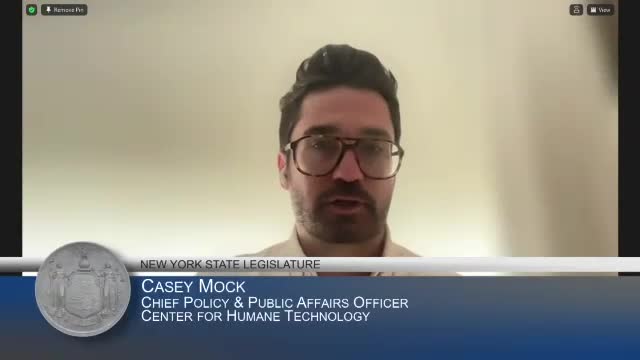Vermont House Bill 711 proposes AI liability standards for developers and deployers
September 20, 2024 | Consumer Affairs and Protection, Standing Committees, House, Legislative, New York
This article was created by AI summarizing key points discussed. AI makes mistakes, so for full details and context, please refer to the video of the full meeting. Please report any errors so we can fix them. Report an error »

On September 20, 2024, the New York State Legislature convened to address critical issues surrounding consumer protection and safety in the rapidly evolving landscape of artificial intelligence (AI). The meeting highlighted the urgent need for regulatory frameworks that hold AI developers accountable for the potential harms their technologies may cause.
A key discussion point was the proposal to classify AI developers as manufacturers, thereby making them liable for defective designs and the resulting damages. This shift aims to standardize legal accountability across the nation, as current court rulings vary significantly from state to state. Advocates argued that establishing a clear duty of care for AI developers is essential. This would require them to take reasonable precautions to mitigate foreseeable risks associated with their products, similar to existing obligations in other industries.
The meeting also underscored the importance of responsible AI deployment. Participants emphasized that developers should be held accountable for how they secure and release their AI models. Reckless practices, such as the careless release of open-source model weights, could lead to significant risks, including unauthorized access to sensitive information and the potential for misuse in harmful ways, such as creating nonconsensual deepfake content.
The discussions drew parallels to historical cases, such as the Ford Pinto, which catalyzed advancements in automotive safety. The sentiment was clear: the tech industry must evolve from its "move fast and break things" mentality to one that prioritizes human safety and ethical considerations. By implementing robust liability frameworks, the hope is to encourage AI companies to invest in safety measures, conduct thorough testing, and ensure accountability when things go wrong.
Additionally, the meeting explored legislative models, such as Vermont House Bill 711, which could serve as a template for New York's approach to AI regulation. The Center for Humane Technology provided insights into bridging the existing liability gap, advocating for a balanced relationship between AI developers and businesses that deploy these technologies.
As the conversation progressed, concerns were raised about the vulnerability of specific populations, particularly senior citizens, to fraud and deception facilitated by AI. This highlights the broader implications of AI technology on consumer safety and the need for comprehensive protective measures.
In conclusion, the New York State Legislature's meeting on AI consumer protection marked a significant step toward establishing a regulatory framework that prioritizes safety and accountability in the tech industry. As discussions continue, the focus will remain on crafting legislation that not only addresses current challenges but also anticipates future risks associated with AI technologies.
A key discussion point was the proposal to classify AI developers as manufacturers, thereby making them liable for defective designs and the resulting damages. This shift aims to standardize legal accountability across the nation, as current court rulings vary significantly from state to state. Advocates argued that establishing a clear duty of care for AI developers is essential. This would require them to take reasonable precautions to mitigate foreseeable risks associated with their products, similar to existing obligations in other industries.
The meeting also underscored the importance of responsible AI deployment. Participants emphasized that developers should be held accountable for how they secure and release their AI models. Reckless practices, such as the careless release of open-source model weights, could lead to significant risks, including unauthorized access to sensitive information and the potential for misuse in harmful ways, such as creating nonconsensual deepfake content.
The discussions drew parallels to historical cases, such as the Ford Pinto, which catalyzed advancements in automotive safety. The sentiment was clear: the tech industry must evolve from its "move fast and break things" mentality to one that prioritizes human safety and ethical considerations. By implementing robust liability frameworks, the hope is to encourage AI companies to invest in safety measures, conduct thorough testing, and ensure accountability when things go wrong.
Additionally, the meeting explored legislative models, such as Vermont House Bill 711, which could serve as a template for New York's approach to AI regulation. The Center for Humane Technology provided insights into bridging the existing liability gap, advocating for a balanced relationship between AI developers and businesses that deploy these technologies.
As the conversation progressed, concerns were raised about the vulnerability of specific populations, particularly senior citizens, to fraud and deception facilitated by AI. This highlights the broader implications of AI technology on consumer safety and the need for comprehensive protective measures.
In conclusion, the New York State Legislature's meeting on AI consumer protection marked a significant step toward establishing a regulatory framework that prioritizes safety and accountability in the tech industry. As discussions continue, the focus will remain on crafting legislation that not only addresses current challenges but also anticipates future risks associated with AI technologies.
View full meeting
This article is based on a recent meeting—watch the full video and explore the complete transcript for deeper insights into the discussion.
View full meeting
